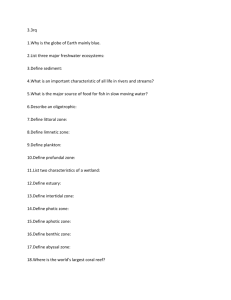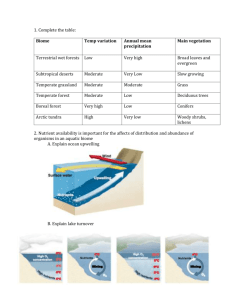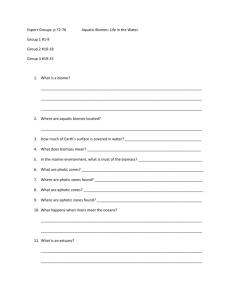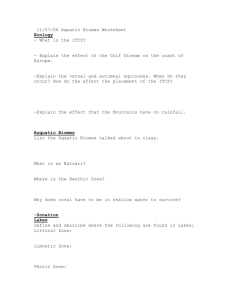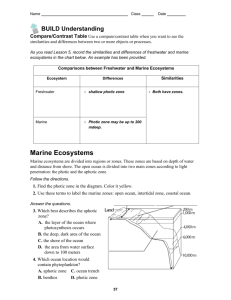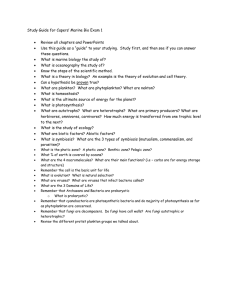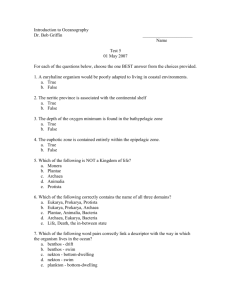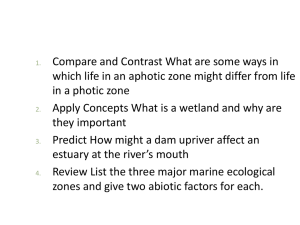Light and Sound
advertisement
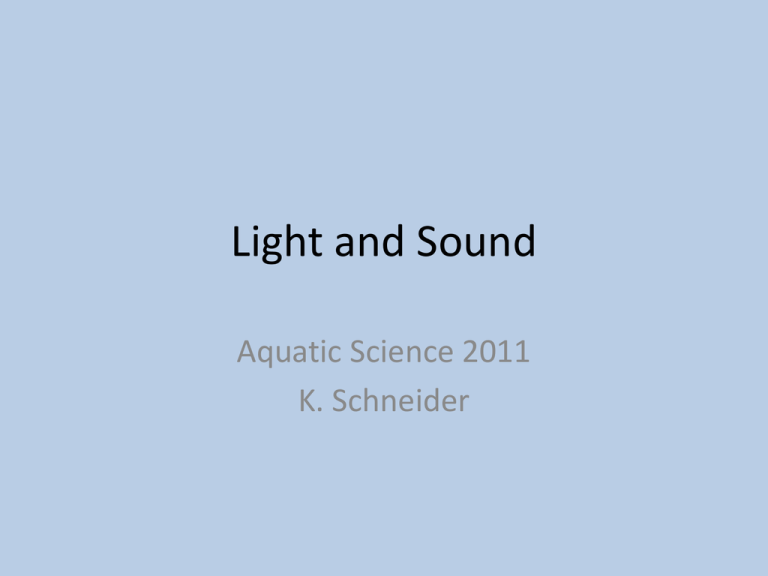
Light and Sound Aquatic Science 2011 K. Schneider Classification by Light • Photo means light • Two ways to classify by light: – Photic zone – Aphotic Zone Continental shelf: part of continent that extends under water to the shelf break Continental slope: continental shelf break to open ocean bottom Continental rise: wedge of sediment between continental slope and abyssal plain Classification by Light • Photic zone – Sunlight top layer of ocean. Two divisions: 1. Euphotic zone 2. Disphotic zone Euphotic Zone • Upper layer of photic zone [Surface to approx.100m (330 ft)] –Actual depth of euphotic zone may vary by location –Depth of euphotic zone is dependent on: »water clarity »productivity –Layer with most biological productivity »Plants, photosynthesis, oxygen, food Disphotic Zone • Disphotic zone (dis = opposite; photic =light) – 2nd layer of photic zone; Twilight zone – Little light, not visible to humans and not enough to power photosynthesis – Some organisms you might find here: lantern fish, rattalk fish, hatchet fish, viperfish, and mid-water jellyfish • Colors: Many organisms are red-colored because red is not reflected well in this zone and thus, looks black • Red organisms are better protected from predators Classification by Light • Aphotic zone = “not light” = dark zone – Extends from photic zone to sea floor – No photosynthesis (cannot occur without light) – Little food (marine snow) – Colder – More pressure than photic zone Classification by Temperature – Eurythermal: upper layer of water where temperature changes with the seasons • “eury” means “wide” or “broad” • “thermal” refers to temperature • So “wide range of temperature” – Thermocline: temperature decreases rapidly with depth • Below eurythermal zone – Disthermal: zone of stable temperature • Below thermocline zone Freezing Temperature – Density is mass per volume – Pure water is at its most dense (1.0 g/cm3) at 4ºC – Freezing temperature of water is dependent on salt concentration » Salt in the water, requires a lower temperature to freeze Warm-up • Describe the photic zone and it’s 2 subdivisions (zones). • What color acts best as camouflage in the Twilight Zone. Why? Sound http://video.pbs.org/video/1777525840 1. What term describes the transmission of sounds by the dolphins? 2. How does it work? factsofworld.com Sound • Form of energy transmitted by rapid pressure changes in an elastic medium • Sound energy decreases as it travels through seawater due to: – Spreading – Scattering – Absorption Decreasing of Sound Energy • Spreading – Loss of energy as sound travels away from the source • Scattering – Occurs as sound bounces off bubbles, suspended particles, organisms, the surface, the bottom, or other objects • Absorption – Eventually absorbed and converted by molecules into very small amount of heat Speed of Sound • Higher frequencies are absorbed sooner – Frequency – Determines pitch of sound • Sound waves travel for much greater distances through water than light waves can before being absorbed. • Because of this, many marine animals use sound instead of light to “see” in the ocean Speed of Sound • In seawater of 35% salinity the speed of sound is about 1500 meters per second (3,345 miles per hour) • Speed of sound increases as temperature and pressure increases – Faster in warmer surface water SOFAR • SOund Fixing And Ranging • Sound waves bend toward layers of lower sound velocity and tend to stay in that zone. • Loud noises made at this depth can be heard for thousands of miles SONAR • SOund Navigation And Ranging • 2 Types of SONAR – Active – Passive SONAR ACTIVE • Projection and return through water of short pulses (“pings”) • Example: Side-scan SONAR PASSIVE • First human use was passive • Listening-only device • Benefit of surprise because a listener can hear the loud “ping” generated by active sonar before an operator can hear the echo Shadow Zone • A region into which very little sound energy penetrates • Created when sound waves arrive at the highvelocity layer, split and refract to the surface or bend into the depth. • An object beyond that area where it splits may not be detected Echolocation • When sound created by an animal is reflected after it strikes an object, it creates an echo. • They locate objects by listening for the reflected echo. • The animal can tell how far away the object is by measuring the time it takes for the echo to return to them. Echolocation – Whales and Dolphins • Used for hunting, navigation, and communication – Whale songs • Generally low frequency • Provides information about the seafloor, the shorelines, underwater obstacles, water depth, and the presence of other animals underwater. Echolocation – Whales and Dolphins • Dolphins use sound to detect the size, shape, and speed of objects hundreds of yards away. • So precise it can determine the difference between a golf ball and a ping-pong ball based solely on density FROM: http://www.pbs.org/wnet/nature/episodes/the-dolphin-defender/dolphins-and-sounds/807/ Echolocation – How does it work? • Water has superb conduction of sound. • Sound waves travel 4.5 times faster in water than they do in the air. • Using nasal sacs in their heads, dolphins send out rapid clicks that pass through their bulbous forehead, or “melon.” • The sound is focused, then beamed out in front of the dolphin. • The sound wave speeds through the water, bounces off the object under investigation, and is reflected back to the dolphin. FROM: http://www.pbs.org/wnet/nature/episodes/the-dolphin-defender/dolphins-and-sounds/807/ Vocabulary 1. 2. 3. 4. 5. 6. 7. 8. Photic Zone Euphotic Zone Disphotic Zone Aphotic Zone Biological productivity Thermocline Eurythermal Disthermal 9. SONAR 10. SOFAR 11. Shadow Zone 12. Bioluminescence 13. Camouflage 14. Echolocation 15. Frequency
